This was published 7 years ago
Cuba cruises: First US cruise ship in 50 years arrives in Havana
By Mimi Whitefield
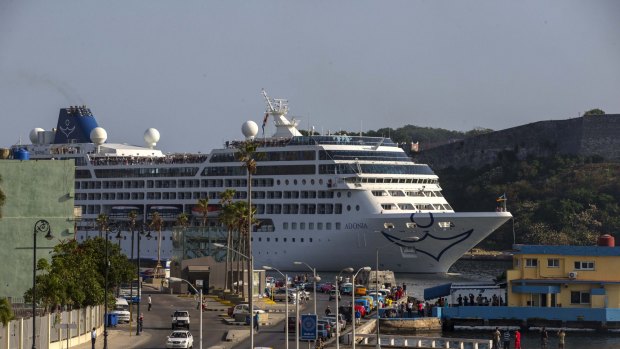
Carnival's Adonia cruise ship arrives from Miami in Havana, Cuba.Credit: AP
As passengers cheered, Carnival's Fathom Adonia arrived at Havana harbour on Monday morning, officially re-establishing the US cruise business in Cuba.
The voyage of the Adonia, with about 600 passengers aboard, was the first trip from Miami to Cuba in more than 50 years, and the importance of the historic trip wasn't lost on anyone.
Aboard the ship, cruise passengers waved Cuban and American flags. In the Old Havana terminal, Cuban flags and banners from Havantur, the official tourism agency, were draped along the second-floor balcony as a crowd of officials, port workers and media welcomed the vessel.
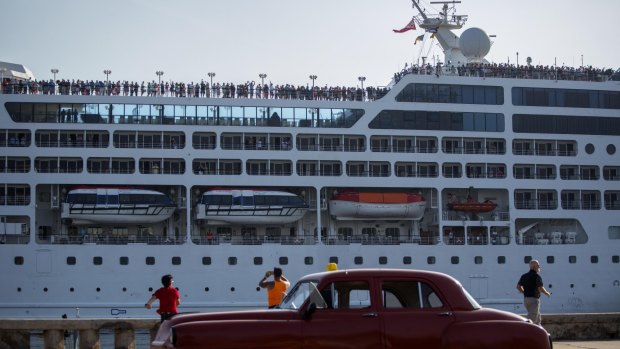
Carnival's Adonia cruise ship arrives from Miami in Havana, Cuba.Credit: AP
Carnival President and CEO Arnold Donald was on the bow of the ship as it came into the harbour. "It was a very special point of view and a very special moment - to feel the emotions of everyone on the ship and then feel the emotions of the people on shore too."
Arnie Perez, Carnival's chief legal counsel, also on the bow, said he was moved by the groups of Cubans along the shore who clapped and cheered. "It made me feel at home," he said.
After the ship officially docked at 10:24 am, Perez and his wife Carmen, both born in Cuba, were first to disembark.
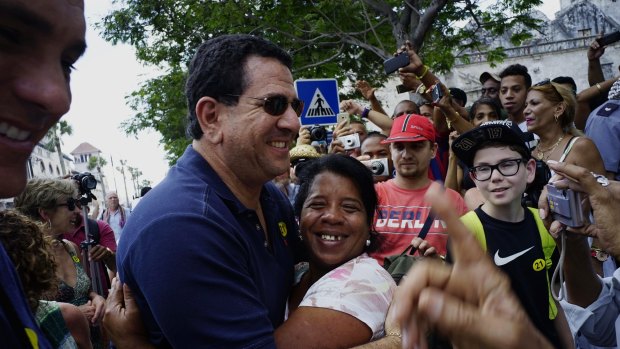
An unidentified passenger of Carnival's Adonia cruise ship, left, and a Cuban woman embrace as locals welcome the cruise passengers from Miami, to Havana, on Monday.Credit: AP
Moored at Havana's westernmost terminal, the imposing blue-and-white ship was clearly visible as it loomed above the Malecon.
After an efficient customs procedure, passengers were greeted with welcome rum and cokes. Several groups of dancers entertained, from young women in spangly Cuban-flagged themed outfits to folkloric dancers who weren't shy about grabbing passengers for a few swings around the exit of the terminal.
A large crowd of Cubans waited across the street from the terminal, many snapping cellphone pictures and shouting "bienvenido" as the passengers began hitting the streets of Old Havana.
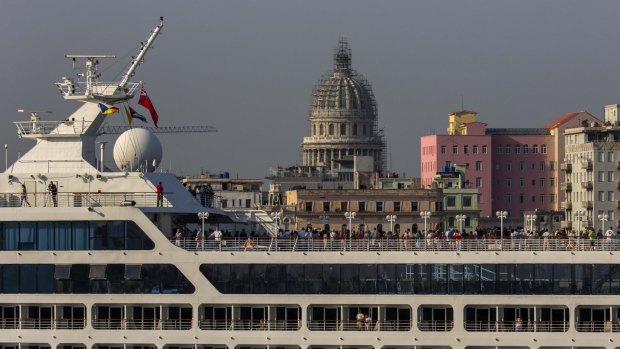
Passengers stand on Carnival's Adonia cruise ship as they arrive.Credit: AP
But four hours later, some guests were complaining that their Old Havana tours seemed to be pretty garden-variety shore excursions, rather than personalised people-to-people encounters that the itinerary promised. A guide walked passengers through the colonial Spanish squares and to the 18th-century Cathedral, pointing out landmark buildings and explaining Cuban history.
For at least one group of 19 passengers, personal encounters were mostly of the commercial kind, as vendors crowded around selling peanuts in little paper cones and sweet fried dough. Artists hawked quick sketches while strolling musicians, jazz combos and costumed characters posed for pictures. On this blazing day, a straw hat vendor drew a brisk business.
Passengers even countered a small black dog in a pair of glasses and little straw hat decked a Cuban flag at work outside the Cathedral. The dog's owner said it earned around $US5 a day - enough to keep it in dog food and more.
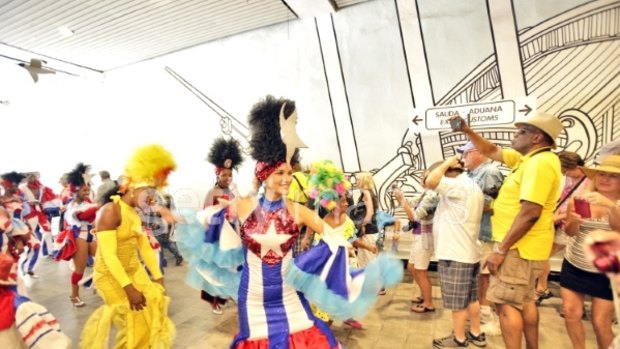
Cuban dancers perform to welcome passengers of the Adonia on Monday.Credit: Mambo Photo
"Hey are you from the cruise ship?" shouted one man in English. "Did you bring me anything?"
Some of the groups ate at private restaurants around Old Havana. But the complement of 600 passengers seeking lunch at the same time taxed the offerings, and some ended up in commercial eateries.
Eileen Ogintz, a family travel expert and syndicated columnist, was with a group assigned to the landmark Hemingway watering hole La Bodeguita del Medio. She enjoyed the meal of shrimp, fish, beef and moros y cristianos at the state-run restaurant and the singers who serenaded during lunch. But four hours into the Old Havana tour, she said, "We haven't interacted with anyone."
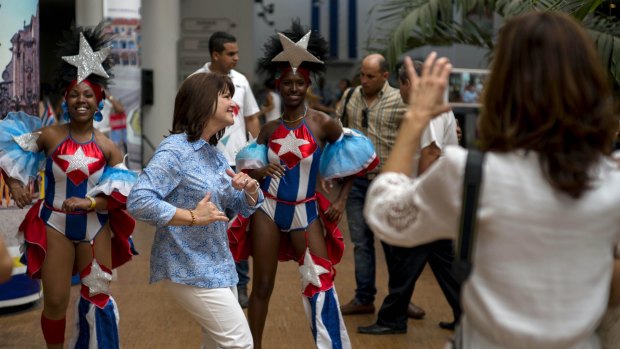
An unidentified passenger of Carnival's Adonia cruise ship dances with a couple of Cuban entertainers, as locals welcome cruise passengers on Monday.Credit: AP
That didn't mean there weren't Cubans who were willing to engage.
During a half hour of free time at the cobbled Plaza de Armas, travelers browsed through stalls of old magazines, books, jewelry, antique cameras, and door knockers and letters slots taken from old houses.
Among locals in the plaza was Francisco de Asis Barreto, a friendly retired merchant marine who collects old bottles and sells them to be recycled. He wasn't part of the tour but he asked if the group would still be in town next weekend. He sings in the choir at the Cathedral, where a special farewell mass for retiring Cardinal Jaime Ortega will be held.
"You know I once saw Miami. Our boat was passing about a mile off shore and it looked very beautiful," he said. "We've always felt Americans are our friends."
The weeklong cruise will circumnavigate Cuba and will also stop in Cienfuegos and Santiago de Cuba. As a people-to-people trip, the voyage is supposed to encourage interactions with the Cuban people.
While baking on the beach is not part of any people-to-people agenda, a wide variety of cultural and artistic activities are permitted.
"It's exciting to be part of this historic voyage," said Shirley Thurman, a retiree from St. Augustine, Fla., who was making the trip with her husband. "I am so glad we are normalizing relations with Cuba. I think the common people in Cuba have been the ones who have suffered over the years."
Thurman said she had no desire to come to Cuba before the U.S. government began liberalizing travel rules, making it easier for a greater variety of Americans to travel to the island as part of an opening toward Havana that began on Dec. 17, 2014.
But the night that Carnival announced the Fathom Adonia would be making its first voyage to Cuba, her husband was on the phone making reservations for the cruise.
All the cabins were sold out for the maiden voyage, although single occupancies meant the ship traveled somewhat below its 704-passenger capacity.
Perez, the Carnival attorney, hadn't been back since last year when he began helping negotiate the deal that led to the Adonia's entry into the Cuban market.
The only member of his immediate family who remains in Cuba is an 89-year-old aunt who lives outside Santiago de Cuba. When the Adonia stops in Santiago, he plans to see the aunt he has never met, he said.
Though the first meeting between the social impact-oriented Fathom brand and Cuban officials was held in July 2015; the line - a subsidiary of Doral-based Carnival - didn't receive final approval until mid-March, he said.
Carnival and Fathom executives underestimated the backlash they got in Miami, when they started to deny Cuban-born travelers passage on the ship in accordance with a Cold War-era Cuban policy barring those born in Cuba from entering or leaving the island by vessel.
Cuban exiles swung into action, protesting what they saw as a discriminatory policy that didn't put the Cuban-born on equal footing with other travelers. Two lawsuits were filed against the cruise lines and opposition to the cruise began piling up. Carnival shifted gears, saying it would sell tickets to Cuban-born travelers and would delay the Adonia's first trip, if necessary, until Cuba changed its policy.
"We made it clear we wouldn't go if they didn't change the policy," said Perez, who was involved in the last-minute negotiations.
On April 22, a statement appeared in Granma, the Communist Party newspaper, making it clear that cruise liners and merchant ships would no longer be subject to the policy.
"Yes, it should have been done earlier. They realize that," said Perez. But he said on Sunday, the day the Adonia left PortMiami, he got a message from the Cuban Embassy in Washington expressing hope that the cruise would go well.
"The time is now to do something different toward Cuba," Perez said. "We're engaging with people and we are hoping for the best."
See also: The top places to visit by ship in 2016
Miami Herald/TNS
Sign up for the Traveller Deals newsletter
Get exclusive travel deals delivered straight to your inbox. Sign up now.